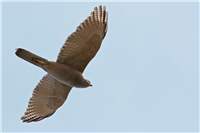Family
Accipitridae
Genus
Accipiter
Species
cirrhocephalus
Threats/Control Methods - Regional
Collared Sparrowhawks need an abundance of tall trees for hunting perches and nesting areas and are therefore vulnerable to land clearing and the loss of mature trees from the suburbs. Foxes (Vulpes vulpes) and both domestic and feral Cats (Felis catus) may take over hunting areas from the Sparrowhawk.
Threats/Control Methods - Local
In times of drought this species is more likely to move into the suburbs, which is not an ideal breeding environment.
Local/Urban Actions
To encourage these birds into suburban yards to hunt introduced birds, gardeners should ensure they have a good mix of large eucalypt trees, thick shrubs and open space.
Common Names
Collared Sparrowhawk, Australian Sparrowhawk, Chicken-hawk
Distinguishing Features
This is a fairly small bird of prey at 30-40cm in size, with a wingspan of 55-80cm. Males are smaller and thinner than females. The head, back, wings and tail are grey, while the underparts are light coloured with red-brown horizontal streaks. A red-brown patch is also found across the sides and back of the neck. This bird has a short, thick and hooked black and yellow bill, yellow eyes and strong, yellow feet with a long middle toe. In flight, the tail appears square. Young birds are browner with v-shaped markings on their underparts.
Survey Techniques
Call and visual identification.
Species Call
A shrill, high-pitched �ki-ki-ki-ki� and a slower, piercing 'kwiek-kwiek-kwieek'.
Similar Species
This species is almost identical in colour and shape to the larger Brown Goshawk (Accipiter fasciatus), however the tail of the Goshawk is more rounded in flight.
Distribution
Collared Sparrowhawks are found in fairly low numbers across most of Australia, excluding the more arid regions in WA and central Australia. They are also found in Papua New Guinea.
Country of Origin
Australia
Conservation (Pet/Pest) Status - Regional
Population numbers are low, but appear fairly steady over the past 25 years (COG).
Conservation (Pet/Pest) Status - National
Secure, not listed under the EPBC Act 1999.
LSCCES Population
Three sightings were made in Turner.
Associated vegetation community
This species is found in a range of areas, including rainforest, open forests, woodland and river corridors through dry country. It has also adapted fairly well to suburbia.
Limiting Resources
Collared Sparrowhawks require a plentiful supply of small birds for food, easily accesable water and a good mix of tall trees and shrubs for hunting and nesting.
Breeding
The breeding season is generally in early spring to summer, taking about 11 weeks. Nests are built of sticks and leaves in high tree forks, a shallow bowl with a 50cm diameter. Leaves are added to the nest as lining throughout the breeding event. 2-4 eggs are laid and incubated by the female for 35-37 days. She then shelters the young after hatching. The male helps out by feeding the female and the young in the month before they leave the nest.
Behaviour
This bird is a swift and crafty hunter, often seen perched patiently before suddenly darting down to the ground to swoop up its moving prey. Upon landing, it wags it tail from side to side, then plucks and eats its catch. It is a fairly secretive bird, however also one of the few birds that will hunt in suburban gardens. During the breeding season, birds call loudly around the nest, however they are not aggressive and calmly care for their eggs and young.
Functional Group
Food Species
The Collared Sparrowhawk will swoop at Rabbits (Oryctolgas cuniculas) and small birds on the ground, occassionaly taking very small birds while they are in flight. Within the suburbs it eats the more abundant small birds, especially introduced Common Starlings (Sturnus vulgaris ).
Predators
This species is to large and fast to have many predators itself and instead predates many small birds. However, Noisy Miners (Manorina melanocephala ) will aggressively attack this bird for dominance over nesting sites.
Interesting Fact
Collared Sparrowhawks have been known to follow their prey into houses.
References - (reader suitability of references, P=Primary teachers, S=Secondary students, T=Tertiary students and researchers)
Books:Morcombe, M. 2000. Field Guide to Australian Birds. Steve Parish Publishing. Archerfield. Australia P, S, T
Schodde, R. and Tideman, S. (eds) 1990. Reader's Digest Complete Book of Australian Birds (2nd Edition). Reader's Digest Services Pty Ltd. Sydney. P, S, T
Veerman, P. 2003. Canberra Birds: A report on the first 21 years of the garden bird survey. Philip Veerman and Canberra Ornithologists Group. Canberra. S, T
Internet: Birds in Backyards. 2006. [online]. Available at:http://www.birdsinbackyards.net P, S, T
Canberra Ornithological Group (COG). 2004. Birds of Canberra Gardens. COG and the ACT Department of Urban Services. [online]. Available at:http://garden.canberrabirds.org.au/ P, S, T
Online Publications: Nix, H. and Cunningham, R. 2006. Birds of the Lower Sullivans Creek Catchment, Canberra ACT. Prepared for the Life in the Suburbs project using data from the Lower Sullivans Creek Catchment Ecological Survey (LSCCES). Australian National University. Canberra. [online]. Available at: http://www.lifeinthesuburbs.com.au/category.php?id=65 S, T
Olsen, P. et al. 2005. The State of Australia's Birds 2006: Invasive Species. Supplement to Wingspan 16:4. Birds Australia. [online]. Available at: http://www.birdsaustralia.com.au/soab/SOAB2006.pdf S, T

 Top
Top Top
Top